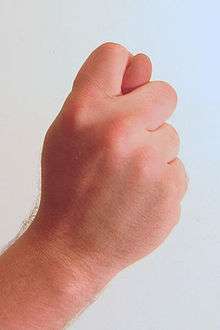Fig sign

The fig sign is a mildly obscene gesture used in Turkish and Slavic cultures and some other cultures that uses two fingers and a thumb. This gesture is most commonly used to deny a request.
Another use of this gesture is for warding off evil eye, jealousy, etc.[1]
In ancient Rome, the fig sign, or mano fico, was made by the pater familias to ward off the evil spirits of the dead as a part of the Lemuria ritual.[2]
The hand gesture may have originated in ancient Hindi culture to depict the lingam and yoni.[1]
Among early Christians, it was known as the manus obscena, or "obscene hand".[1]
Recently, the Russian word for this gesture has also become a term in Padonkaffsky jargon to refer to Control-Alt-Delete. Svitlana Pyrkalo, a producer at the BBC World Ukrainian Service, explained that "you need three fingers to press the buttons. So it's like telling somebody (a computer in this case) to get lost, and "three fingers" is a euphemism for the fig sign, which is a mildly obscene word in Russian language."[3]
The letter "T" in the American manual alphabet is very similar to this gesture.
International nomenclature
- In Italy this sign, known as mano in fica ("fig-hand"), or far le fiche (cunt gesture), for the resemblance to female genitalia, was a common and very rude gesture in past centuries, similar to the finger, but has long since fallen out of use.[1] Notably, a remnant of its usage is found in Dante's Divine Comedy (Inferno, Canto XXV).
- In Greece and particularly in the Ionian Islands this gesture is still used as an alternative to the moutza. It is known as a "fist-phallus", and can be accompanied by extending the right hand while clasping the left hand under one's armpit in a derogatory manner.[1]
- In Japan this sign is called セックス (sekkusu) and means sex. Since 1989, it has fallen into disuse.[4]
- In Russia, it is used when denying a request. For example, when asked to hand something over, a child might make the gesture, thereby implying that they will not give it.
- In many countries, such as the United States of America, the United Kingdom, Ireland, France, Denmark, and the Czech Republic, this sign has no obscene meaning and is instead used in a game where you "steal" someones nose. You will usually do this with small children where you pretend to take their nose and then say "I've got your nose". The thumb represents the "stolen" nose held between your index and middle finger. This innocent meaning may exist alongside the obscene one, for example in Germany.
See also
| Wikimedia Commons has media related to Kukish. |
References
- 1 2 3 4 5 Hamilton, Terri. Skin Flutes & Velvet Gloves. 2007. pp.279-80.
- ↑ Adkins, Lesley (2004). Handbook to Life in Ancient Rome: p317.
- ↑ Kleinman, Zoe (16 August 2010). "How the internet is changing language". BBC News. Retrieved 16 August 2010.
- ↑ Hamiru-aqui (2008). 70 Japanese Gestures. Translated by Aileen Chang. Stone Bridge Press. pp. 98–99. ISBN 978-1933330013. Retrieved June 19, 2013.